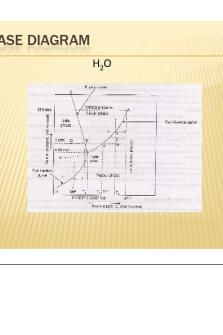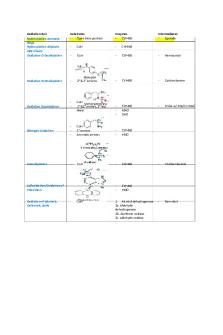Binary Solid-Liquid Phase Diagram PDF

| Title | Binary Solid-Liquid Phase Diagram |
|---|---|
| Author | Sarah Robinson |
| Course | Foundations of Professional and Technical Communication |
| Institution | University of Houston-Downtown |
| Pages | 9 |
| File Size | 383.4 KB |
| File Type | |
| Total Downloads | 112 |
| Total Views | 169 |
Summary
bla...
Description
Sarah Robinson Chem 3310 Fall 2020 Binary Solid-Liquid Phase Diagram Abstract The purpose of this lab was to determine the eutectic point and enthalpy of fusion of a binary liquid mixture of Naphthalene and Diphenylamine along with their respective melting point if they were pure. The enthalpy of fusion was determined for naphthalene to be 21.90kJmol-1, and the melting points for naphthalene was calculated to be 80.04˚C. Diphenylamine’s enthalpy of fusion was determined to be 13.57kJmol-1 with a melting temperature of and 53.85˚C. The eutectic point was determined to be 30.6% mole percent naphthalene at a temperature of 32.4 ˚C. Introduction In this lab, a solid-liquid phase diagram was constructed using several cooling curves of a mixture at different compositions. The arrest and breaks of the cooling curves were used to determine the temperatures for the points at each composition. The phase diagram was used to determine the eutectic point of the mixture. Eutectic points are a specific temperature and composition in a eutectic system where both components freeze at a lower temperature than they would when pure. Simply put, Eutectic mixtures are mixtures of multiple substances that do not react to create a new substance but instead have a particular ratio of the two substances that has a lower melting point than the either pure substance has.1 Eutectic mixtures can be between two or more components, in this lab two were used, which were naphthalene and diphenylamine. Along with the phase diagram, the melting temperatures and enthalpy of fusion was determined through the use of the equation of the line of the natural logarithm of mole fraction versus inverse temperature graphs. Enthalpy was calculated using Slope = - ΔHi/R which is obtain from equation 1. The melting temperature of the pure compounds were calculated using equation two.
ln X
A
H A R
1 1 T T A
(1)
Procedure To create the cooling curves for pure naphthalene 5.0g was added to a small test tube, the smaller test tube was placed into a larger tube, and then heated in a hot water bath until the naphthalene was fully liquefied. The test tube was allowed to cool in a cold-water bath while stirring continuously and recording the temperature every fifteen seconds until the temperature was below 30C. Once solid, for run 2, 1.0g of Diphenylamine was weight out and added to the 5.0g naphthalene. The mixture was heated again until all solid had liquefied and cooled while stirring and recording the temperature every 15 seconds. The steps were repeated by adding diphenylamine at 1.50g for the third run, 2.50g for the fourth, and 5.00g for the fifth. For the sixth run a different tube was obtained and 5.0g of diphenylamine was added to the tube. The tube was place into another larger tube and heated and cooled as in runs 1-5, recording the temperature every 15 seconds until it began to solidify. In run seven, 1.0g of naphthalene was added to the 5.0g of diphenylamine and the previous steps were repeated. Finally, for the last determination (run 8), 0.67g of naphthalene was added and the previous steps were repeated. Results
Temperature
Run #1 Temperature vs. Time 87 86 85 84 83 82 81 80 79 78 0
50
100
150
Time
200
250
Run #2 Temperature vs. Time 90 85 80 75 70 65 60 55 50 45
0
50
100
150
200
250
300
Run #3 Temperature vs. Time 90 80 70 60 50 40 30
0
50
100
150
200
250
300
350
400
Run #4 Temperature vs. Time 75 70 65 60 55 50 45 40 35 30
0
100
200
300
400
500
600
Run #5 Temperature vs. Time 70 65 60 55 50 45 40 35 30 25
0
100
200
300
400
500
600
Run #6 Temperature vs. Time 75 70 65 60 55 50
0
50
100
150
200
250
Run #7 Temperature vs. Time 70 65 60 55 50 45 40 35 30
0
50
100
150
200
250
300
350
Run #8 Temperature vs. Time 70 65 60 55 50 45 40 35 30
0
XNaphthalene 1 0.868451 0.725328 0.569031 0.397654 0 0.2089 0.30604
50
100
150
200
Arrest temp (C) 81.5
250
300
350
Break temp (C) 73.8 64.3 50.3 47.6
54.2 38 32.4
400
450
Ln(XNa) vs. 1/Temperature 0
0
f(x)0= − 2634.32 x +07.46
0
0
0
0
0
-0.1 -0.2 -0.3 -0.4 -0.5 -0.6 -0.7 -0.8 -0.9 -1
Ln(Xdi) vs. 1/Temperature 0.05 0
0
0
f(x) = − 1632.30x + 4.99
0
0
0
0
-0.05 -0.1 -0.15 -0.2 -0.25 -0.3 -0.35 -0.4
Discussion The objective of this lab was to construct a binary liquid-solid phase diagram, to determine the eutectic composition and the temperature depression at that composition, and the melting temperatures and enthalpy of fusion of each pure compound. The eutectic composition was found to be 30.6% mole percent naphthalene and the temperature of melting at the eutectic composition was found to be 32.4C. The melting temperatures for naphthalene and Diphenylamine was calculated to be 80.2C and 53.85C, respectively, And the enthalpy of fusion for each was calculated to be 21.9kjmol-1 and 13.57kJmol-1 respectively. The percent error of the enthalpy and melting temperature calculated for Naphthalene was calculated as 23% and 0.15%, respectively. And the percent error of the enthalpy and melting temperature calculated for Diphenylamine was calculated as 31.8% and 1.6%.
There were a few possible places were error could have been introduced in the lab. One source could have come from impurities in the samples of naphthalene of diphenylamine. Impurities in either could have affected the melting temperatures substantially depending on the purity of either. Another source could have come from water being introduced into the tube from the condensation after cooling or the water from the water bath. Water being introduced into the mixtures would have caused the freezing temperature to be lower than normal. And a final additional minor source of error could have been caused by inconsistent stirring of the mixtures. Discontinuous stirring could have caused the temperature measure as the melting temperature to be inaccurate due to uneven cooling throughout the liquid. This error would have been shown in the cooling curves causing extra breaks in the curves.
Appendix Composition calculations Run 1 Moles B=
5g =0.03932 mol B 127.17 g mol−1
X Naphthalene=
0.039 01 =1 0.03 901 Run 2
Moles A=
1g =0.0059 1 mol A 169.23 g mol−1
X Naphthalene=
0.03 901 =0.868 0.039 01+0.0059 1 Run 3
Moles A=
2.5 g =0.0 1477 mol A 169.23 g mol−1
X Naphthalene=
0.039 01 =0.725 0.039 01+0.0 1477 Run 4
Moles A=
5g =0.0 2955 mol A 169.23 g mol−1
X Naphthalene=
0.039 01 =0.569 0.03 901+0.0 2955 Run 5
Moles A=
10 g =0.0 5909 mol A 169.23 g mol−1
X Naphthalene=
0.03901 =0.398 0.03901+0.0 5909 Run 6
Moles A=
5g =0.0 2955 mol A 169.23 g mol−1
X Diphenylamine=
0.02955 =1 0.02955 Run 7
Moles B=
1g =0.00780 mol B 127.17 g mol−1
X Diphenylamine=
0.0 2955 =0.791 ; X Naphthalene =0.209 0.02955+ 0.00780 Run 8
Moles B=
1.67 g =0. 01303 mol B 127.17 g mol−1
X Diphenylamine=
0.0 2955 =0.694 ; X Naphthalene=0.306 0.02955+ 0 .01303 Naphthalene Calculations
Pure Naphthalene MeltingTemperature= Enthalpy of fusion of Naphthalene=−2634.3 Pure Diphenylamine Meltingtemperature=
K∗8.314 J ÷ 1000=21.9016 kJ mol−1 Kmol
−−1632.3 =326.846 K =21.90C 4.9941
Enthalpy of fusion of Diphenylamine=−1632.3
Temperature of Naphthalene % error =
−−2634.3 =353.036 K =80.0358 C 7.461
K∗8.314 J ÷ 1000=13.5709 kJ mol−1 Kmol
80.16−80.04 ∗100=0.15 % 80.16
Temperature of Diphenylamine % error =
53.0 −53.85 ∗100=1.6 % 53.0
Enthalpy of fussion ofNaphthalene % error = Enthalpy of fussion ofNaphthalene % erro r =
21.90 −17.8 ∗100=¿ 23.0% 17.8
19.9 −13.57 ∗100=31.8 % 19.9
References 1. Alhadid, A.; Mokrushina, L.; and Minceva, M. Design of Deep Eutectic Systems: A Simple Approach for Preselecting Eutectic Mixture Constituents. Molecules. [Online] 2020, 25(5), 1077. https://www.ncbi.nlm.nih.gov/pmc/articles/PMC7179121/ (accessed Nov 14, 2020)...
Similar Free PDFs

PHASE DIAGRAM (DIAGRAM FASA
- 14 Pages

Phase Diagram
- 4 Pages

Binary practice
- 5 Pages

Phase Rule
- 21 Pages

Phase 1 and phase 2 reactions
- 8 Pages

TRAFO 1 PHASE DAN 3 PHASE
- 13 Pages

MAKALAH BINARY SEARCH
- 9 Pages

Binary Search Trees
- 3 Pages

Linear and Binary Search
- 6 Pages
Popular Institutions
- Tinajero National High School - Annex
- Politeknik Caltex Riau
- Yokohama City University
- SGT University
- University of Al-Qadisiyah
- Divine Word College of Vigan
- Techniek College Rotterdam
- Universidade de Santiago
- Universiti Teknologi MARA Cawangan Johor Kampus Pasir Gudang
- Poltekkes Kemenkes Yogyakarta
- Baguio City National High School
- Colegio san marcos
- preparatoria uno
- Centro de Bachillerato Tecnológico Industrial y de Servicios No. 107
- Dalian Maritime University
- Quang Trung Secondary School
- Colegio Tecnológico en Informática
- Corporación Regional de Educación Superior
- Grupo CEDVA
- Dar Al Uloom University
- Centro de Estudios Preuniversitarios de la Universidad Nacional de Ingeniería
- 上智大学
- Aakash International School, Nuna Majara
- San Felipe Neri Catholic School
- Kang Chiao International School - New Taipei City
- Misamis Occidental National High School
- Institución Educativa Escuela Normal Juan Ladrilleros
- Kolehiyo ng Pantukan
- Batanes State College
- Instituto Continental
- Sekolah Menengah Kejuruan Kesehatan Kaltara (Tarakan)
- Colegio de La Inmaculada Concepcion - Cebu






